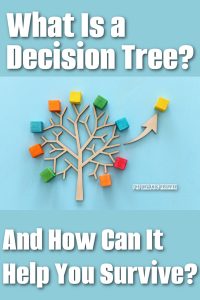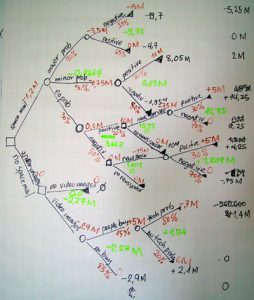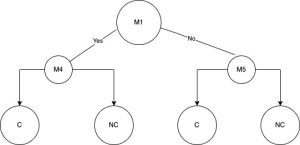 By Daisy Luther
By Daisy Luther
There are times when one second is all you have between life and death. At times like that, your ability to think rapidly and circumvent your natural freeze response can mean the difference between being a survivor and being a victim.
But, the question is, how on earth do you make decisions that quickly when you don’t have time to think your actions through?
The answer is, by thinking this through in advance.
Of course, we cannot predict every scenario we may experience. Some things are so shocking that they appear to come out of left field. A friend of mine said recently in an online group chat where we were discussing the Hamas attacks, “If I looked out my kitchen window and saw guys parachuting into my backyard with guns, I have no idea what I’d do!”
I said, “Shoot them. There’s no justifiable reason anyone would ever do that in the US.”
Why was that my first response?
Because I use decision trees on a regular basis to wargame scenarios and speed up my own responses. This is an activity that anyone of any fitness level and any economic situation can do and it’s a great preparedness exercise. But what is a decision tree? Let’s talk about it.
What is a decision tree?
This is a model I learned about when I took a business course online. I immediately thought of its application to non-business uses when I heard about it.
It is an analysis that helps you to determine possible outcomes, assess risks, and predict your chances for success if certain actions are taken. Here’s an explanation from Wikipedia.
A decision tree is a decision-support hierarchical model that uses a tree-like model of decisions and their possible consequences, including chance event outcomes, resource costs, and utility…
…A decision tree is a flowchart-like structure in which each internal node represents a “test” on an attribute (e.g. whether a coin flip comes up heads or tails), each branch represents the outcome of the test, and each leaf node represents a class label (decision taken after computing all attributes). The paths from root to leaf represent classification rules.
In decision analysis, a decision tree and the closely related influence diagram are used as a visual and analytical decision support tool, where the expected values (or expected utility) of competing alternatives are calculated.
A decision tree consists of three types of nodes:
- Decision nodes – typically represented by squares
- Chance nodes – typically represented by circles
- End nodes – typically represented by triangles
Decision trees are commonly used in operations research and operations management. If, in practice, decisions have to be taken online with no recall under incomplete knowledge, a decision tree should be paralleled by a probability model as a best choice model or online selection model algorithm.
Another use of decision trees is as a descriptive means for calculating conditional probabilities.
Decision trees, influence diagrams, utility functions, and other decision analysis tools and methods are taught to undergraduate students in schools of business, health economics, and public health, and are examples of operations research or management science methods.
 Be Ready for Anything: How to Survive Tornadoes, Earthquakes, Pandemics, Mass Shootings, Nuclear Disasters, and Other Life-Threatening Events
Be Ready for Anything: How to Survive Tornadoes, Earthquakes, Pandemics, Mass Shootings, Nuclear Disasters, and Other Life-Threatening Events
These are things you can write down but once you get the hang of it, you can also create them in your head to help you to make decisions. The following photos are some visual examples of decision trees. The factors in them don’t matter – it just shows you how they work.
So, the way it works is, you have your starting point – the top of the tree – which is the beginning of the problem you are trying to solve. Next you have your potential actions. There could be two or three different choices here. Then, you have your potential outcomes for each action, both good and bad. Your outcomes may also require decisions which is why some trees have more branches, depending on the complexity of the problem. You can also do it as an “if yes then THIS” and “if no then THAT” format for simplicity’s sake.
How does this apply to survival?
Let’s go back to my friend’s hypothetical situation of seeing guys parachute into her backyard with automatic weapons. The first question here for me to answer in my decision tree is, “What reason would anyone have to parachute into my suburban yard with a large rifle?”
Then, I could go along with possible answers to that question.
- It’s our own military.
- It’s a criminal escape gone wrong.
- It’s some kind of crazy gang warfare.
- It’s a terror attack.
- It’s literal Red Dawn.
None of these options is a good one, is it? Is there any situation in which this is going to be okay?
- If it were our own military, they wouldn’t be landing in my backyard. If a member of our own military was, for some bizarre reason, parachuting into my backyard, they wouldn’t be holding a rifle ready to open fire on people the second they land. He wouldn’t be part of a group landing in my yard if he’d had to bail out of a plane – he’d be the only guy.
- If it was a group of criminals escaping from custody by parachuting out of a plane (I watch too much TV, clearly), they’re ready to take people out.
- If it’s gang warfare, this is some next-level stuff and it’s not going to go well for anyone who just stands there.
- If it’s a terror attack, they know what their next action is, and it will be to create as high of a death toll as possible they can the moment they’re stable enough to shoot.
- Red Dawn? See above.
So out of all those possibilities, the only one in which it would be wrong to shoot would be if the people landing were members of our military or law enforcement. The likelihood of that is pretty dad-gum low. (Of course, the likelihood of anyone looking out while doing the dishes and seeing gun-wielding paragliders is also low, but clearly, it can – and did – happen.)
When you see something THAT out of the ordinary, surprise is on their side, not on yours. They already know what’s happening. Two things have the potential to save you – your ability to process the information fast and take action or dumb luck. Which would you prefer to rely on?
You can use this as a mental exercise whenever you watch the news or read about current events. I regularly read true crime, and when I do, I think through the things that are happening to the victims. What could she have done to save herself? How could she have prevented that outcome? It’s not about blaming the victim. It’s about not being the victim should I find myself in a similar scenario.
Now obviously, if you run into a shocking emergency, I don’t expect you to pull out the paper and markers and draw yourself a tree as shown above. But if you get into the habit of thinking things through in this kind of organized fashion, it will help to move you past the freeze response, speed up your decision-making process, ask yourself the urgent questions, and move on to action much faster.
What could go wrong?
This isn’t foolproof. The same friend who brought up the “what if” scenario reminded me of something we learned when we went to Prepper Camp. We took a fantastic class together about psychological warfare given by Hakim Isler. He brought up a very important point that sometimes we come up with answers in our heads that seem perfectly reasonable and rational, but what we’re really seeing is something we’ve never even considered before. Maybe it’s simply something outside of our experience, or perhaps it’s such a wild card that it never crossed our minds.
You must always leave room in your decision tree for a wild card like that. There could always be something you never considered. But use this to allow yourself to collect more information. Don’t let it paralyze you.
Ways to wargame
There are a lot of different ways to wargame extreme scenarios, and a lot of them are actually entertaining. I’m a regular player of the What If Game. I have been since I was a little girl. (Yes, it used to drive my parents crazy.)
 I still play the What If Game. Here are some opportunities for What-Iffing and making decision trees:
I still play the What If Game. Here are some opportunities for What-Iffing and making decision trees:
When you watch or read the news, if a particular story catches your eye, do some research. Learn more about what happened from multiple sources, then put yourself in the position of the people who experienced it. Make a decision tree – what are the possible reasons X is happening? What is the appropriate response to each of those reasons?
When you read prepper and survival fiction, think through the story. How the characters respond might not be how you respond. How would the scenario be different in your location? How would you respond? How could you protect yourself? Is there anything you can do in advance to make a bad outcome less likely? Here are some awesome books for adults our readers enjoyed and here are some for children and teens.
When you watch television shows or movies, do the same thing. It doesn’t even have to be incredibly realistic for you to drop yourself into that world and wonder, “What if?” Here are some movies with a survival or preparedness theme, or you can find a series here to binge-watch.
Thinking through any scenario helps you to come to solutions more quickly when time is of the essence. It can be an enjoyable activity for the whole family, and you just never know when thinking fast could save a life.
Thinking about emergencies before they happen is critical.
We cannot possibly predict every bad thing that could ever happen but we can predict some of them. By wargaming the ones that are possible – and we know they’re possible because we saw that it happened to someone else – it can help us to cut down on our decision-making time if something similar happens to us.
A long time ago, I was discussing the human freeze response with a friend of mine who served in active war zones for years. He told me that he doesn’t have a decision process when he sees the enemy coming over the hill. It’s automatic for him to raise his rifle up and shoot. He has so much training and so much experience in situations like this that his response times are honed to milliseconds.
But the rest of us may not have a similar background.
We all want to stop…hit pause…take a second to think things through. But that is not always possible. I fear we are looking at a future that is far more dangerous, what with heated events in the world and declared enmities. The likelihood of us being present when something horrific happens has just gone up.
Will you be ready to take action if it happens to you? This is an article that can help you stay safer. You can purchase How to Survive During Dangerous Times, a 661-page PDF book that contains this and other articles to help you improve your responses to crises, prepare your home, and improve your OPSEC.
Have you heard of decision trees before? Have you ever used them in your workplace? Is it something you could see yourself applying to preparedness and survival situations?
Let’s discuss it in the comments section.
Source: The Organic Prepper
Daisy Luther is a coffee-swigging, adventure-seeking, globe-trotting blogger. She is the founder and publisher of three websites. 1) The Organic Prepper, which is about current events, preparedness, self-reliance, and the pursuit of liberty; 2) The Frugalite, a website with thrifty tips and solutions to help people get a handle on their personal finances without feeling deprived; and 3) PreppersDailyNews.com, an aggregate site where you can find links to all the most important news for those who wish to be prepared. Her work is widely republished across alternative media and she has appeared in many interviews.
Daisy is the best-selling author of 5 traditionally published books, 12 self-published books, and runs a small digital publishing company with PDF guides, printables, and courses at SelfRelianceand Survival.com You can find her on Facebook, Pinterest, Gab, MeWe, Parler, Instagram, and Twitter.
Become a Patron!
Or support us at SubscribeStar
Donate cryptocurrency HERE
Subscribe to Activist Post for truth, peace, and freedom news. Follow us on SoMee, Telegram, HIVE, Minds, MeWe, Twitter – X, Gab, and What Really Happened.
Provide, Protect and Profit from what’s coming! Get a free issue of Counter Markets today.




Be the first to comment on "What Is a Decision Tree and How Can It Help You Survive?"